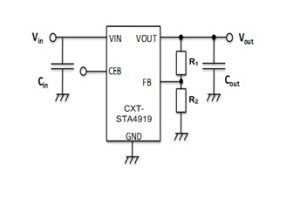Texas Instruments has introduced a hex level translator for logic that can also be used as a line-driver. Called SN74LV6T17-EP and part of the LVxT logic family, it contains six independent buffers with Schmitt-trigger inputs. The output level is referenced to the supply voltage, which can span 1.6 to 5.5V and supports 1.8, 2.5, 3.3 and 5V cmos levels. The ...
Tag Archives: logic
Scope, logic analyser, waveform generators and more from PC instrument
Powered and operated through a USB Type-C cable, Analog Discovery 3 is a 9MHz (or 30MHz) 125Msample/s 14bit oscilloscope, a logic analyser, an arbitrary waveform generator and more from Digilent. “Analog Discovery 2, AD3’s predecessor, has been used as a learning tool in hundreds of universities, and as a flexible benchtop tool by thousands of professional engineering companies and organisations ...
Automotive logic level shifter is automatically bi-directional
Diodes has automotive qualified a four-bit bidirectional level translator that does not require a direction control pin. Its B and A ports are designed to track two different power supply rails (VccB and VccA). “Flexibility is maximised because VccA can be set to a value that is independent and either greater than or less than the VccB supply,” according to the company. ...
Mini modules combine driver chip and output mosfets for dc-dc converters up to 100A
Vishay has announced power stages for synchronous buck converters that allow a logic-level PWM signal to control 70, 80 or 100A outputs. There are six parts that will handle inputs from 4.5 – 16V (see table below) then four that will handle 4.5 – 21V – there is no 100A option in the higher voltage devices. Different versions are tuned for 3.3 ...
Re-updated: Handy pulse stream divide-by-n for the lab
Presented with a rotary sensor challenge, I needed a divide-by-13 for a pulse stream. The correct answer was to programme an 8pin ATtiny85 to do the job, but I didn’t want to be distracted by re-climbing the programming learning curve. Circuit (right) updated to avoid potential mis-counts So I had a quick Google for a one-chip answer and came across ...
Improved: isolated wide range zero-crossing detector needs no power switch
A while ago I needed a piece of test gear – an isolated way to transfer zero-crossing information from a variable ac power source: 1Vp-p to 200Vp-p 1Hz to ~1kHz The exact zero crossing point is not important in this application, as long as some point in each cycle is transferred across consistently. And this is what I came up ...
‘Microchip Technology Caldicot’ in Wales works on nano-relay logic project
Microchip has changed the name of its UK subsidiary that is working on nano-relay-based logic and memory for an EU ultra-low-power computing and memory project. Caldicot-based Microsemi Semiconductor is now ‘Microchip Technology Caldicot’. “The organisation is the lead partner in the ZeroAMP Project, an industry-driven initiative funded by the Horizon2020 EU Research and Innovation Program that is focused on developing ...
PCIM: 175°C linear reg and logic gates for automotive
Cissoid has announced an adjustable linear regulator and logic gates that operate with junction temperature from -55°C up to 175°C – exceeding AEC-Q100 Grade 0 standard, the Belgian high-rel chip maker pointed out. Members of the firm’s new CXT series of automotive grade components, all with the same temperature range, the first is CXT-STA4919, a 50mA adjustable linear voltage regulator that can create ...
Electronica: NXP claims smallest 8pin logic ever
Aiming at phones and IoT, 8pin logic is now available in 0.8 x 1.35mm packages – the smallest yet claims NXP. The SOT1233 devices, which the firm calls GX 8 packaging, are only 0.35mm high. “The GX 8 leadless package addresses the continual trend in electronic systems towards smaller and smaller packages, low-power consumption and low system costs,” said the firm. ...
Ferrite-Cores And Transistor-Based Logic Here To Stay
‘Commenting upon the apparently universal adoption of ferrite-core storage and transistor-based logic in contemporary computers, the science correspondent of a Sunday newspaper recently concluded that a period of stability in computer technology was now with us.’ So, 52 years ago, starts a story in Electronics Weekly’s edition of May 17 1961.
 Electronics Weekly Electronics Design & Components Tech News
Electronics Weekly Electronics Design & Components Tech News








